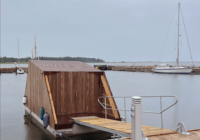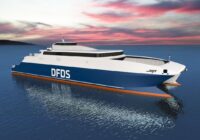Riviera’s Electrical Design Manager, Matt Weetman, shares his recommendations on how to manage a healthy power system while on board your Riviera.
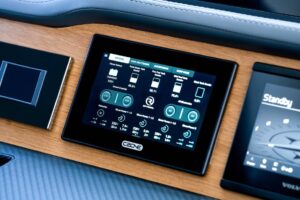
All the Riviera power sources and systems work in tandem to ensure that your stay on board is as enjoyable as possible. All they require is a keen eye to monitor them through CZone and adjust as needed.
As soon as you leave your marina berth, you are truly off-grid.
Do you have enough fuel? Is there food on board for the entire voyage? Is there enough fresh water in the tanks? These are things we think about before every trip, but there is another important resource you need to manage while on board your Riviera: your electrical power.
No doubt your rituals include switching on the lights, checking the fridges and icemaker are operating as normal, and powering up the systems and navigation screens at the helm.
Riviera’s Electrical Design Manager, Matt Weetman, says the best way to manage the power on your Riviera is to become familiar with the highly sophisticated power resources your yacht offers.
“Your Riviera has three sources of electrical power on board, with three systems to distribute the power throughout the yacht,” says Matt.
“The more familiar you are with your yacht’s sophisticated electrical system, the more prepared you will be when you are living aboard for days or weeks at a time.”
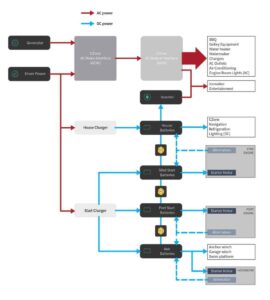
This schematic diagram illustrates the Riviera on board power supply and distribution system.
MATT’S RECOMMENDATIONS FOR A HEALTHY POWER SYSTEM:
- Check the state of house batteries regularly – every hour, even if you are on charge.
- Use your inverter sparingly – it draws more power from the house batteries than you may be aware of.
- Ensure your house batteries are charged to 100 percent before retiring for the night.
- As a rule of thumb, run your AC systems via shore power or the generator 50% of the time in a day, in four-hour allotments as a minimum. This is to ensure the longevity of the batteries and replenish them through a full charge cycle.
- Have your systems checked at least once a year by a specialist Riviera electrician, particularly battery health and connections.
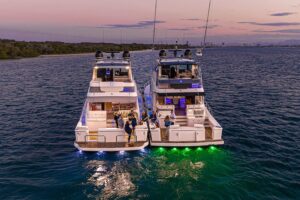
POWER MANAGEMENT ON YOUR RIVIERA
Your Riviera has three sources of electrical power on board, with three systems to distribute the power throughout the yacht.
The first and primary source of power on board are the batteries. This is a highly sophisticated system selected by Riviera engineers for both safety and reliability. It includes your house batteries that are set up to run all household items such as lighting and fridges. This is the battery source that CZone monitors while you’re on board and alerts you when power is getting low. It is also the system that requires the most attention, as it powers all of the systems you interact with while on board. Check the CZone system to see the State of Charge (SOC), and whether the vessel is charging or discharging power from its capacity.
The second source of power is your generator. This is your on-board power station. It provides AC power throughout the yacht, enabling you to run the air-conditioning, all the galley appliances, your cockpit barbecue, as well as access via power points throughout the yacht. It also runs your Battery Chargers, which we will discuss later, to recharge the critical batteries on board.
The third source of power is your shore power. You should always use this whenever moored. This system is limited by what is available at your marina berth but should always be sufficient to provide charge back into the batteries on board.
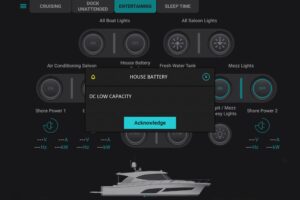
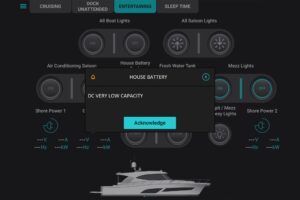
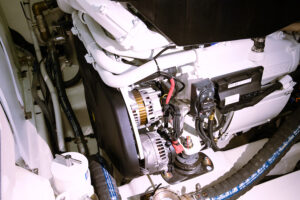
Alternators are DC charge systems that are powered by the drive on the engines. There is generally always an alternator dedicated to each battery bank.
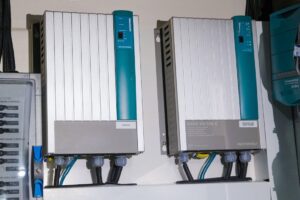
The battery chargers take AC power from your generator – or shore power when docked. The inverter takes the DC power in your house batteries and transfers it to AC power.
The three power transfer systems are designed to get power to where you want it, with some restrictions designed into the yacht to ensure you can always get home safely.
The first power transfer system is the inverter system. It takes the DC power in your house batteries and transfers it to AC power on dedicated circuits for items such as your TV’s, icemaker and some select outlets throughout the yacht. These systems have been selected to ensure that you can enjoy being aboard and still feel like you’re at home. However, it takes a large amount of DC power to use the Inverter. Always monitor what power you’re using from the house battery bank when using inverted systems to be sure you’re on top of the system usage.
The second is the two charging systems: the battery chargers and the alternators. These systems function separately but for the same goal, charging your battery banks and providing DC power for the yacht.
The battery chargers take AC power from your generator – or shore power when docked – and delivers it to charge your batteries back to capacity, also taking the electrical load for the systems being used on board.
The alternators are DC charge systems that are powered by the drive on the engines. There is generally always an alternator dedicated to each battery bank, so starting an engine should see two battery systems charge.
The key thing here to is to think about how much power is being used on board when engaging the charging systems, as this generally means that power is not being used to charge the batteries. This includes running entertainment systems, and how many times you open and close the fridges during charging, as these systems will continue to draw power which is no longer going into your battery banks.
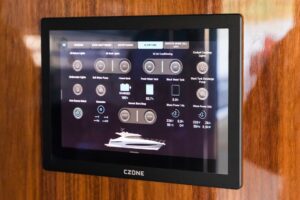
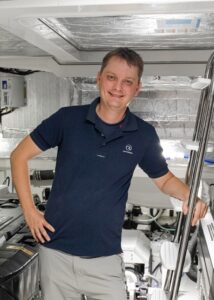
The third and final power transfer system is the battery parallel system. This is the last resort and to be used if power is lost to any one of the battery banks. This system allows power to be distributed from one battery bank to another, allowing for a generator to be started or the navigation system to be powered in emergency conditions.
All these systems work in tandem to ensure that your stay on board is as enjoyable as possible. All they require is a keen eye to monitor them through CZone and adjust as needed.
Points to remember:
- You won’t want to run your engines 24 hours a day while you are at anchor. But as soon as those engines are stopped, other power source systems must take over.
- Fortunately, you have a system on board that constantly monitors the state of your power and will alert you when you are running low. The CZone system provides information about the amount of useable power you have available.
- As long as you are monitoring the state of charge for the house battery bank, the rest of the systems will be maintained. Should the battery banks’ charge get low, re-charge them with the use of the generator. Should the battery bank drain too quickly, shutdown the inverted loads, or limit opening the refrigerators.
- When you and your guests are ready to retire for the night, check CZone again to ensure that it’s displaying 100 percent of useable power. There is also a CZone sleep time mode that will help you reduce power consumption overnight.
For more information on how to manage electrical power while on board your Riviera, please refer to your owners manual or consult your Riviera representative.








